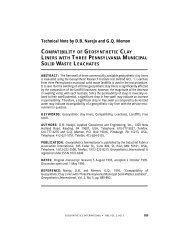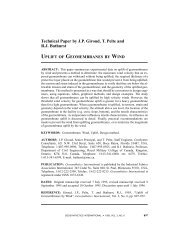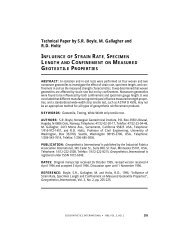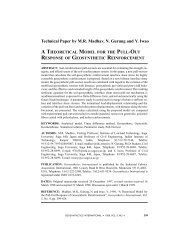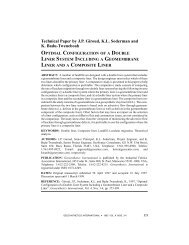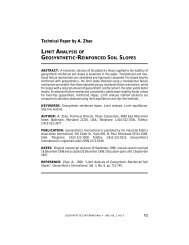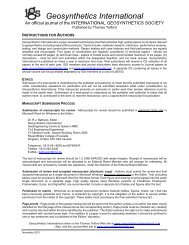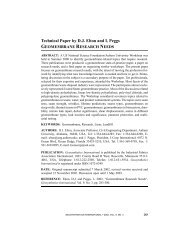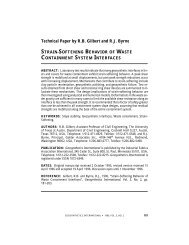discharge capacity of prefabricated vertical drains confined in clay
discharge capacity of prefabricated vertical drains confined in clay
discharge capacity of prefabricated vertical drains confined in clay
Create successful ePaper yourself
Turn your PDF publications into a flip-book with our unique Google optimized e-Paper software.
MIURA AND CHAI D Discharge Capacity <strong>of</strong> Prefabricated Vertical Dra<strong>in</strong>s Conf<strong>in</strong>ed <strong>in</strong> Clay<br />
y<br />
x<br />
Conf<strong>in</strong><strong>in</strong>g<br />
pressure,<br />
F=Bσ<br />
Ts<strong>in</strong>α<br />
Tensile force, T<br />
α<br />
Core<br />
B<br />
Deformed filter<br />
(circular arc)<br />
Figure 7.<br />
Calculation <strong>of</strong> the reduction <strong>of</strong> the dra<strong>in</strong>age area.<br />
By vary<strong>in</strong>g the value <strong>of</strong> α (Figure 7) (and therefore, the radius <strong>of</strong> the arc), balance<br />
between the conf<strong>in</strong><strong>in</strong>g pressure and the mobilized tensile force <strong>in</strong> the filter can be obta<strong>in</strong>ed<br />
(trial and error). The reduction <strong>of</strong> the cross-sectional area <strong>of</strong> the dra<strong>in</strong>age channel<br />
is a function <strong>of</strong> the filter deformation behavior and the geometry <strong>of</strong> the dra<strong>in</strong>age channel.<br />
Based on the test results, the relationships between conf<strong>in</strong><strong>in</strong>g pressure and the reduction<br />
<strong>of</strong> the cross-sectional area <strong>of</strong> the dra<strong>in</strong>age channels were calculated and are<br />
shown <strong>in</strong> Figures 8a to 8d for PVDs A to D, respectively. Figure 8 <strong>in</strong>dicates that under<br />
a conf<strong>in</strong><strong>in</strong>g pressure <strong>of</strong> 49 kPa, deformation (<strong>in</strong>clud<strong>in</strong>g creep) <strong>of</strong> the filter reduces the<br />
cross-sectional area <strong>of</strong> the dra<strong>in</strong>age channel by approximately 5% for PVDs A and C,<br />
and approximately 20% for PVDs B and D. Compar<strong>in</strong>g the amount <strong>of</strong> reduction after<br />
one day, one month, and one year (extrapolated), it can be seen that under a conf<strong>in</strong><strong>in</strong>g<br />
pressure <strong>of</strong> 49 kPa, most <strong>of</strong> the cross-sectional area reduction is due to short-term deformation<br />
and the creep deformation is small. The PVD D filter is strong, but the perimeter<br />
length <strong>of</strong> the filter sleeve is longer than the perimeter length <strong>of</strong> the core, and the<br />
core is weaker. In particular, the extra length <strong>of</strong> the filter sleeve contributed approximately<br />
15% to the reduction <strong>of</strong> the cross-sectional area <strong>of</strong> the dra<strong>in</strong>age channel. The<br />
test results <strong>in</strong>dicate that PVD filter deformation is not a dom<strong>in</strong>at<strong>in</strong>g factor for <strong>discharge</strong><br />
<strong>capacity</strong> reduction.<br />
For PVDs A and C, before term<strong>in</strong>at<strong>in</strong>g the <strong>clay</strong>-<strong>conf<strong>in</strong>ed</strong> tests, hydraulic shockswere<br />
applied by firmly stepp<strong>in</strong>g on the <strong>in</strong>let hose or rapidly vary<strong>in</strong>g the head difference. By<br />
do<strong>in</strong>g so, the f<strong>in</strong>e particles (or bio-films) were partially pumped out <strong>of</strong> the dra<strong>in</strong>age<br />
channels <strong>of</strong> the PVD core. Then, the <strong>discharge</strong> capacities were recovered to a value correspond<strong>in</strong>g<br />
to that <strong>of</strong> approximately one week <strong>of</strong> elapsed time (Figures 4a and 4c). This<br />
<strong>in</strong>directly <strong>in</strong>dicates that clogg<strong>in</strong>g <strong>of</strong> the PVD core is the ma<strong>in</strong> mechanism reduc<strong>in</strong>g the<br />
<strong>discharge</strong> <strong>capacity</strong> with time. It was observed that, dur<strong>in</strong>g application <strong>of</strong> the hydraulic<br />
shocks, flocculated f<strong>in</strong>e particles were forced out <strong>of</strong> the PVD dra<strong>in</strong>age channels and deposited<br />
on the wall <strong>of</strong> the outlet hose. Also, after the <strong>discharge</strong> <strong>capacity</strong> test, the filter<br />
was analyzed us<strong>in</strong>g electron-microscope photographs. There were bio-films on the<br />
dra<strong>in</strong>age-channel side <strong>of</strong> the filter (Chai and Miura 1999). Air bubbles trapped <strong>in</strong> the<br />
dra<strong>in</strong>age channels were also considered a possible cause <strong>of</strong> the <strong>discharge</strong> <strong>capacity</strong> re-<br />
128 GEOSYNTHETICS INTERNATIONAL S 2000, VOL. 7, NO. 2



